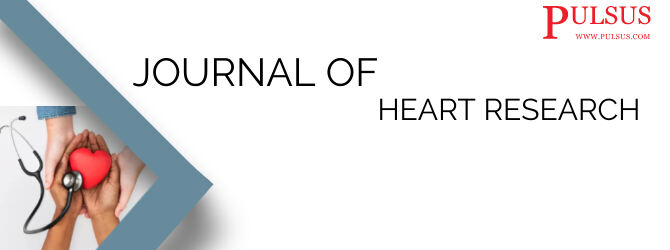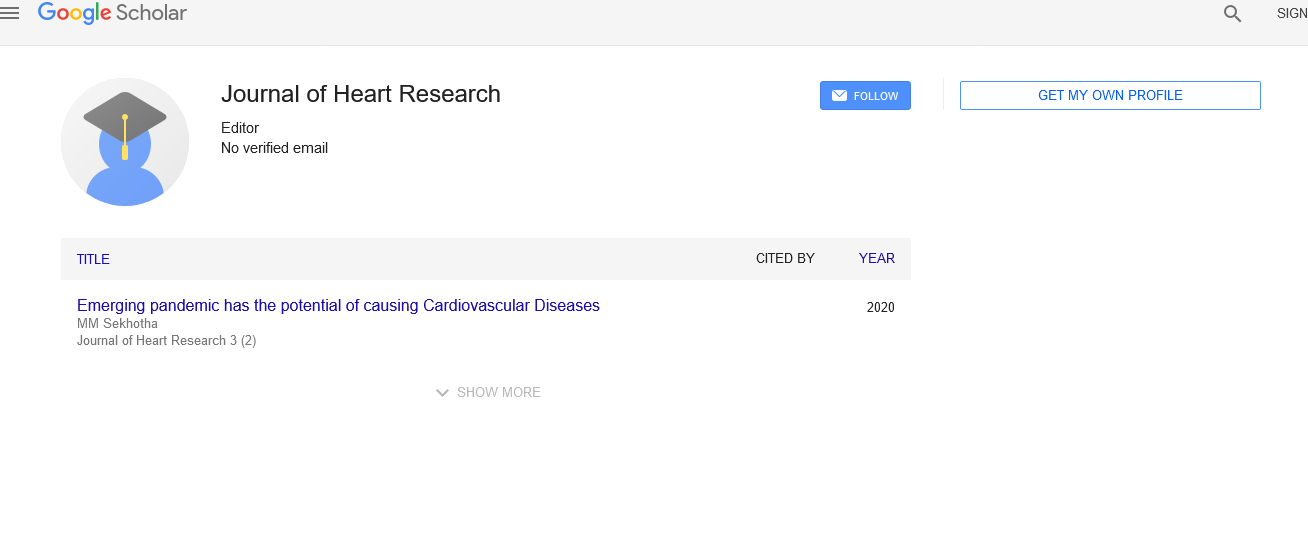Cardiovascular magnetic resonance in convalescent COVID-19 patients
Received: 06-Jun-2022, Manuscript No. puljhr-22-5036; Editor assigned: 08-Jun-2022, Pre QC No. puljhr-22-5036 (PQ); Accepted Date: Jun 24, 2022; Reviewed: 18-Jun-2022 QC No. puljhr-22-5036 (Q); Revised: 21-Jun-2022, Manuscript No. puljhr-22-5036 (R); Published: 27-Jun-2022, DOI: 10.37532/puljhr.22.5(3).23-24
Citation: Minsky D. Cardiovascular magnetic resonance in convalescent COVID-19 patients. J Heart Res. 2022; 5(3):23-24.
This open-access article is distributed under the terms of the Creative Commons Attribution Non-Commercial License (CC BY-NC) (http://creativecommons.org/licenses/by-nc/4.0/), which permits reuse, distribution and reproduction of the article, provided that the original work is properly cited and the reuse is restricted to noncommercial purposes. For commercial reuse, contact reprints@pulsus.com
Abstract
Multi-organ failure is a serious issue in COVID-19 due to the development of severe viral pneumonia combined with a systemic inflammatory response. Nearly 60% of individuals with pre-existing cardiovascular problems have cardiac involvement, which predicts a poor clinical outcome. Increased levels of circulating cardiac damage biomarkers and transthoracic echocardiography are used to make diagnoses during the acute phase of COVID-19. However, these tests failed to identify the mechanisms of heart damage in COVID-19 individuals. Given the possible clinical repercussions, identifying the key hallmarks of heart damage remains a critical yet unmet requirement in cardiology.
Keywords
cardiology; COVID-19; cardiovascular magnetic resonance; heart damage
Introduction
Due to its unique capacity to examine the characteristics of cardiac tissue, Cardiovascular Magnetic Resonance (CMR) offers an unrivaled chance to get a deeper understanding of the myocardial injury. This effort is especially critical in COVID-19 convalescent patients, as many of them still have chest discomfort, palpitations, dyspnea, and exertional tiredness six months or more after the acute illness. The majorities of persons infected with the Severe Acute Respiratory Syndrome Corona Virus-2 (SARS-CoV-2) are asymptomatic or have moderate symptoms. During the early stages of the pandemic, 15% of patients required hospitalization, and up to 5% required critical care therapy due to severe COVID-19 infection [11]. As a result of vaccination, their numbers have dropped globally. In the United Kingdom, for example, the hospitalization rate for vaccinated individuals fell to 3.7% in January, while the entire population fell to 7% [2]. These estimates may change again as new virus strains (such as omicron) emerge that necessitate higher levels of population immunity. Although viral pneumonia is the most common symptom of COVID-19, it can also induce cardiovascular problems such as acute myocardial infarction, arrhythmias, and thrombosis [3]. COVID-19 has found that cardiovascular involvement is a major independent predictor of in-hospital death. Cardiovascular involvement was most commonly detected at hospital admission, as evidenced by chest pain or elevated circulating biomarkers (cardiac troponins (cTn) or natriuretic peptides), and was found to be associated with disease severity, elevated inflammatory markers, advanced age, and cardiovascular risk factors. As a result, elucidating the long-term clinical effects of COVID-19-mediated heart damage is a critical but unmet need in cardiology.
Because of its unrivalled capability in measuring cardiovascular structure and function, as well as accurate, precise, and in-depth tissue characterization of the myocardium, Cardiovascular Magnetic Resonance (CMR) can be a leader in this field. COVID-19, despite being primarily a respiratory disease, can damage several organs in its acute phase, especially in patients with moderate to severe infection and pre-existing comorbidities [4]. Because of the very high prevalence of cardiovascular involvement in hospitalized COVID-19 patients and the detrimental impact on clinical outcome, it has gotten a lot of attention. Myocardial damage, defined as an increase in high-sensitivity cTn beyond the 99th percentile of the upper reference limit, has been reported in 20%-30% of COVID-19 patients, with a prevalence of up to 55%-62% in patients with preexisting cardiovascular problems. Myocarditis-like injury, acute thrombo-embolic illness of the coronary (acute coronary syndrome) or pulmonary arterial circulation, arrhythmias, and cardiogenic shock are all possible consequences of the virus [5]. Given the rarity of endomyocardial biopsy or CMR in hospitalized patients, the mechanisms of myocardial damage remain unknown. Direct impacts on cardiomyocytes or endothelial cells, indirect effects owing to hypercoagulability, and injury caused by cytokine storm or autoimmune are all postulated pathways for SARS-CoV-2-mediated cardiac injury [6].
Cardiovascular Damage in Convalescent COVID-19 Patients
Long-term cardiovascular problems in convalescent individuals are a source of concern. Half of the patients with SARS-CoV-2 infection who were followed up after hospitalization had at least one symptom at 12-month follow-up, with 30%, 9%, and 7% of those complaining of persistent dyspnea, palpitations, and chest discomfort, respectively.
In unstable, hospitalized COVID-19 patients, cardiac biomarkers such as cTn and natriuretic peptides, as well as Transthoracic Echocardiography (TTE), are undeniably important. TTE revealed abnormalities in nearly two-thirds of individuals with increased cTn, including left ventricular wall motion abnormalities (24%), as well as global dysfunction (18%). TTE revealed LV anomalies in 39% of COVID-19 patients in a study of over 1,200 hospitalized patients, but did not identify the underlying reason in many of them. According to a recent meta-analysis, right ventricular dysfunction caused by pulmonary and direct RV injury affects one out of every five COVID-19 patients and is linked to all-cause death.
Impact of Vaccination
Acute myocarditis cases have recently been reported after antiCOVID vaccination with spike protein mRNA. Similar findings from the United States show that following the second dose of mRNA-1273 and the first dose of BNT162b2-mRNA, an elevated incidence of acute myocarditis (8 per 100,000 people) occurs. While 65%-97% of acute myocarditis cases resolved on their own, long-term follow-up data is still sparse, particularly in convalescent COVID-19 patients or other potentially susceptible populations, necessitating further surveillance.
Discussion
In all, 16%-83% of convalescent COVID-19 patients had a cardiovascular finding 1-10 months following the acute phase, according to these CMR studies. When compared to patients with initially severe COVID-19 who require hospitalization, individuals with initially asymptomatic or mild COVID-19 who do not require hospitalization appear to have a lower rate of abnormal CMR findings with accompanying elevation in cTn.
In convalescing patients, the principal clinical characteristics of COVID-19-mediated cardiac damage often differ from traditional viralmediated myocarditis, especially in people with less severe disease. Pericarditis, for example, is a rare symptom of COVID-19 in the acute phase. Given the growing evidence of cardiac and multi-organ damage caused by SARS-CoV-2 infection in both acute and post-acute disease stages, it is clear that enhanced multidisciplinary therapy of persons with persistent symptoms is required.
REFERENCES
- Hippisley-Cox J, Coupland CA, Mehta N, et al. Risk prediction of covid-19 related death and hospital admission in adults after covid-19 vaccination: national prospective cohort study. BMJ. 2021; 374:n2244.
Google Scholar CrossRef - Nishiga M, Wang DW, Han Y, et al. COVID–19 and cardiovascular disease: from basic mechanisms to clinical perspectives. Nat Rev Cardiol. 2020; 17:543-58.
Google Scholar CrossRef - Zhou F, Yu T, Du R, et al. Clinical course and risk factors for mortality of adult inpatients with COVID-19 in Wuhan, China: a retrospective cohort study. Lancet. 2020; 395:1054-62.
Google Scholar CrossRef - Gupta A, Madhavan MV, Sehgal K, et al. Extrapulmonary manifestations of COVID-19. Nat Med. 2020; 26:1017-32.
Google Scholar CrossRef - Siripanthong B, Asatryan B, Hanff TC, et al. The pathogenesis and long-term consequences of COVID-19 cardiac injury. JACC Basic Transl Sci. 2022; 7:3(Part 1)294-308.
Google Scholar CrossRef - Huang L, Yao Q, Gu X, et al. 1-year outcomes in hospital survivors with COVID-19: a longitudinal cohort study. Lancet. 2021; 398:747-58.
Google Scholar CrossRef





